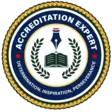Introduction: Why Higher Ed Leaders Need a Change Playbook in 2025
Higher education is facing a moment of reckoning. Enrollment is down, costs are up, and the expectations of students, employers, and regulators have never been higher. The traditional playbook? It’s showing its age.
Leaders, whether you’re a president, founder, or investor, can no longer afford reactive fixes or one-off strategies. The institutions that will thrive in 2025 and beyond are the ones that know how to lead change from the inside out.
This playbook is for you. It’s designed for those making tough decisions, managing risk, and carrying the responsibility of an institution’s future. Inside, you’ll find tested frameworks, leadership insights, and step-by-step guidance to lead change that actually works, in the boardroom, in the classroom, and across campus culture.

Why Most Change Efforts Fail: A Look Behind the Curtain
Change doesn’t fail because the idea was bad. It fails because the conditions weren’t ready. Here’s where most efforts go sideways:
- Old Mindsets Die Hard: Tenured faculty and legacy teams often see change as a threat. You won’t always hear the resistance, but you’ll feel it in missed deadlines, vague objections, and ideas that quietly stall.
- No Urgency, No Movement: Announcements don’t drive action. People need to understand why this matters now, not eventually.
- Systems That Say “No” to Change: If your budgets, org charts, and KPIs still reflect the old way, no amount of vision will push things forward.
Fix these root issues early, or risk wasting time and trust.
Understanding the Scope: 3 Types of Change in Higher Ed
Not all change is created equal. Here’s a simple way to size up the challenge ahead:
1. Incremental Change
Small, steady improvements to existing processes.
Example: Updating syllabi to reflect digital literacy or modernizing admissions forms.
2. Transformational Change
Broad, structural shifts to how things run.
Example: Moving from seat-time-based to competency-based education models.
3. Revolutionary Change
Big, bold moves are often triggered by crisis.
Example: Full pivot to online operations or rebranding under new ownership.
Each type demands a different tempo, leadership stance, and level of stakeholder buy-in.
What Actually Makes Change Stick in Higher Ed
We’ve worked with dozens of institutions, and here’s what the successful ones have in common:
1-Start with a Clear, Compelling Narrative
Data alone won’t move hearts. Help people feel what’s at stake: student success, accreditation, jobs, and survival.
2-Build a Real Change Coalition
You can’t do this from the president’s office. Assemble a cross-functional team with credibility, influence, and skin in the game.
3-Put Resources Where Your Vision Is
Allocate budget, time, and training. Break plans into phases tied to outcomes, not just timelines.
4-Align the Structure with the Vision
If hiring, budgeting, and promoting still reward the old way, your change won’t hold. Update governance and ops to match the future you want.
5-Communicate Like It’s Your Job (Because It Is)
Silence breeds fear. Speak early, often, and clearly across various formats, including email, meetings, dashboards, and one-on-ones. Transparency builds momentum.
How AI Is Shaping Change Management in Higher Education
AI isn’t just a tech trend; it’s a force multiplier. Used well, it accelerates every phase of institutional transformation. Here’s where it’s changing the game:
- Smarter Decision-Making
- Tools like Civitas Learning and Power BI now surface risks and opportunities before humans even ask the right question. Georgia State uses these tools to keep students on track—and it’s paying off.
- Better Communication and Feedback Loops
- AI-powered platforms like Intercom and Qualtrics help you hear what your stakeholders really think, in real time.
- Curriculum That Meets the Market
- Platforms like Light Cast and LinkedIn Learning map your programs to real labor market demand. WGU uses these to make sure its degrees still matter.
- Execution That Doesn’t Fall Apart
- Asana, Trello, and Notion are now infused with AI features that keep your teams aligned and your plans moving.
- Live KPIs for Real Accountability
- Dashboards from Tableau and Qlik show change adoption by department, down to the week. This isn’t just reporting. It’s real-time leadership.
AI tools now help manage timelines, automate workflows, and ensure departments stay aligned and on task.
Explore how Strategic Planning for Higher Education supports AI-driven execution and accountability.
AI can now be leveraged across multiple dimensions of institutional operations, far beyond just automation. Here’s how AI is influencing change management strategy across higher ed institutions in 2025:
From Project to Culture: Making Change Permanent
AI platforms are now capable of analyzing vast datasets, enrollment trends, academic performance, and financial forecasts, and surfacing actionable insights. This reduces reliance on intuition or delayed committee reports.
Change shouldn’t fade with the end of a pilot or leadership transition. Here’s how you make it stick:
- Update bylaws and governance documents
- Tie evaluations to new metrics
- Celebrate internal champions often
- Set up a permanent change committee
Also, don’t forget compliance. Accreditation and federal rules matter. Build them into your change governance from day one.
Real Institutions. Real Results.
Georgia State University uses predictive analytics to identify students at risk of dropping out and deploys timely interventions. The model helped increase graduation rates and close equity gaps across demographics.
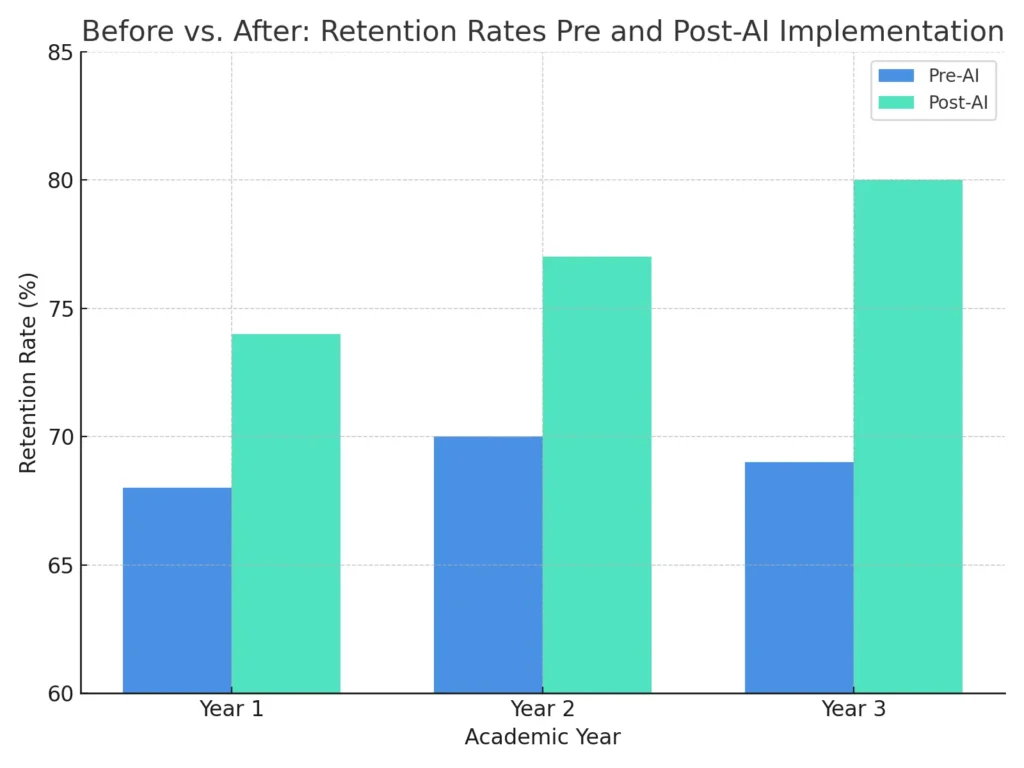
Tools in Use:
- Civitas Learning – Student success analytics
- EAB Navigate – Institutional data modeling
- Power BI with Azure ML – Customized dashboards for forecasting
Enhanced Stakeholder Communication and Feedback
One of the top causes of change failure is poor communication. AI tools now automate and personalize messaging across stakeholder groups, enabling institutions to gather input, answer questions, and surface resistance points in real-time.
Real-World Use Case:
Southern New Hampshire University implemented AI-powered chatbots during large-scale changes to their advising model, reducing student complaints and improving satisfaction scores.
Tools in Use:
- Intercom + GPT – Scalable AI chat for admissions and advising
- Pendo and Qualtrics XM – Sentiment and feedback analytics
- Ada Support – Low-code chatbots for higher ed
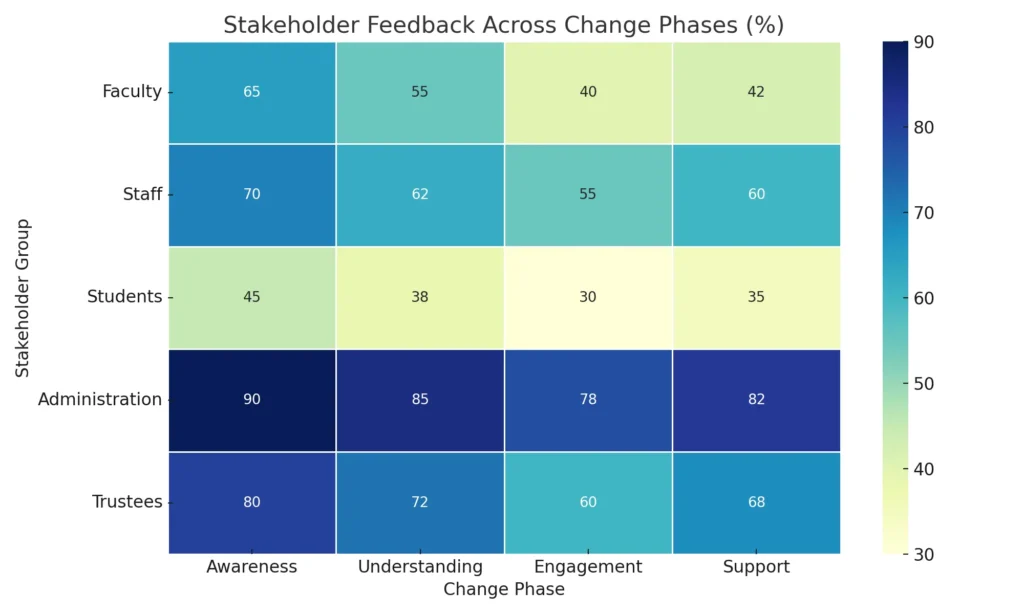
Curriculum and Labor Market Alignment
Change is strategic only if it matches external demand. AI now connects curriculum planning with real-time labor data, helping institutions identify which programs need to expand, evolve, or sunset.
Real-World Use Case:
Western Governors University uses AI to map industry skill needs and continuously update its CBE programs.
Tools in Use:
- Lightcast (formerly Emsi Burning Glass) – Job market intelligence
- LinkedIn Learning Hub – AI-driven skills mapping
- CourseTune – Curriculum planning based on workforce alignment
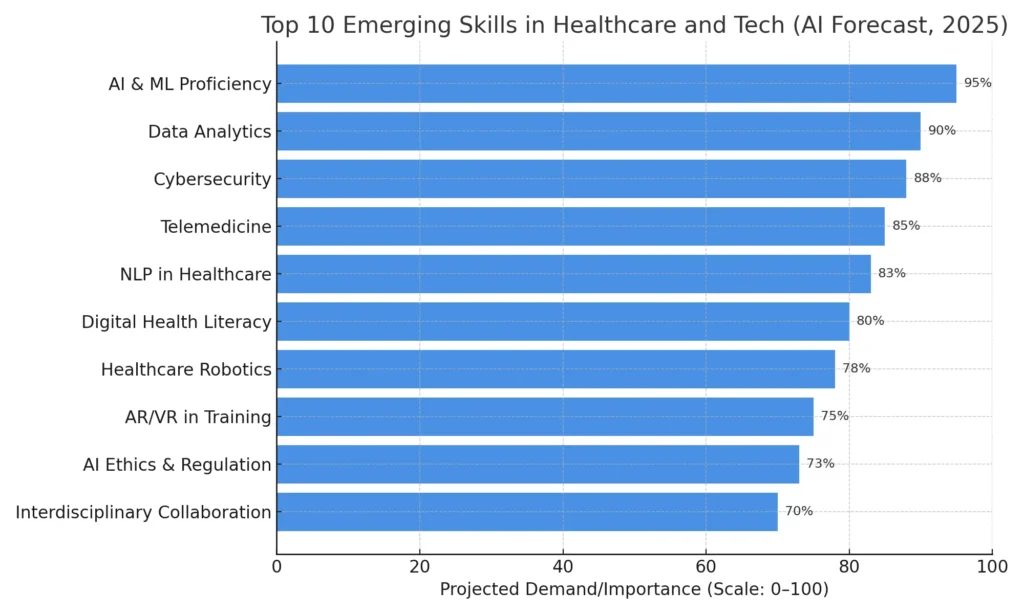
AI-Driven Implementation Support
Even well-designed strategies fall apart at the implementation stage. AI tools now help manage timelines, automate workflows, and ensure departments stay aligned and on task.
Real-World Use Case:
A large private college in Texas used Monday.com + Zapier AI integrations to automate curriculum revision tasks across five departments during a major accreditation renewal.
Tools in Use:
- Asana Intelligence – AI-generated project plans
- Trello + Butler AI – Automated workflow prompts
- Notion AI – Real-time strategy notes, summaries, and reminders
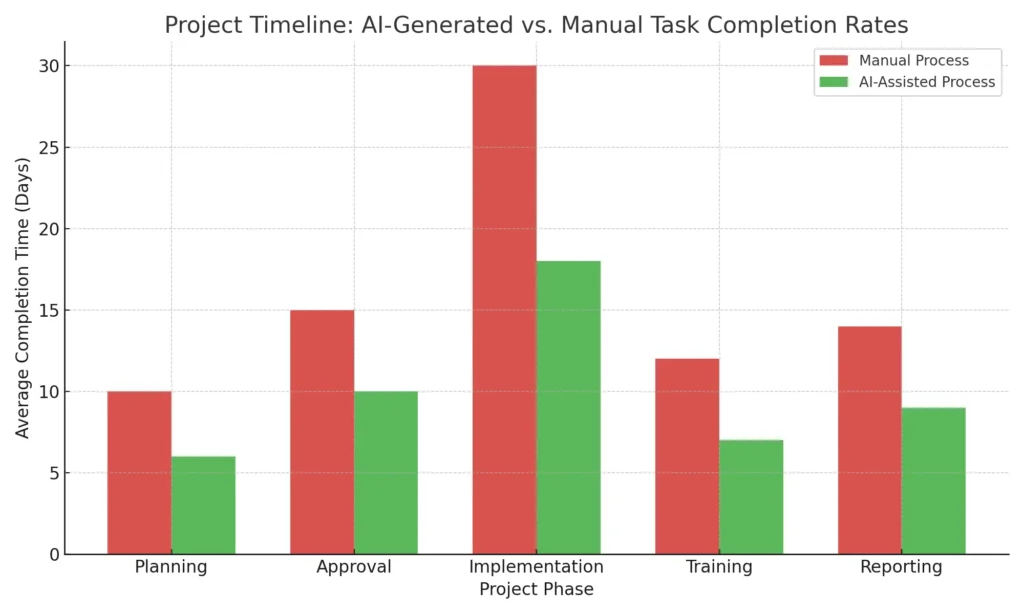
Real-Time Monitoring and KPI Tracking
AI allows leadership to monitor whether change is actually taking hold—and where it’s stalling. Dashboards can now pull from multiple systems (student info, HR, budget) and alert leaders when something’s off course.
Real-World Use Case:
A California-based university system integrated an AI dashboard to monitor diversity hiring initiatives, reporting progress to trustees and external accreditors with live data.
Tools in Use:
- Tableau + Einstein Analytics – Custom KPI dashboards
- Qlik Sense – Cross-functional data visibility
- Looker Studio (Google Cloud) – Compliance-linked reporting
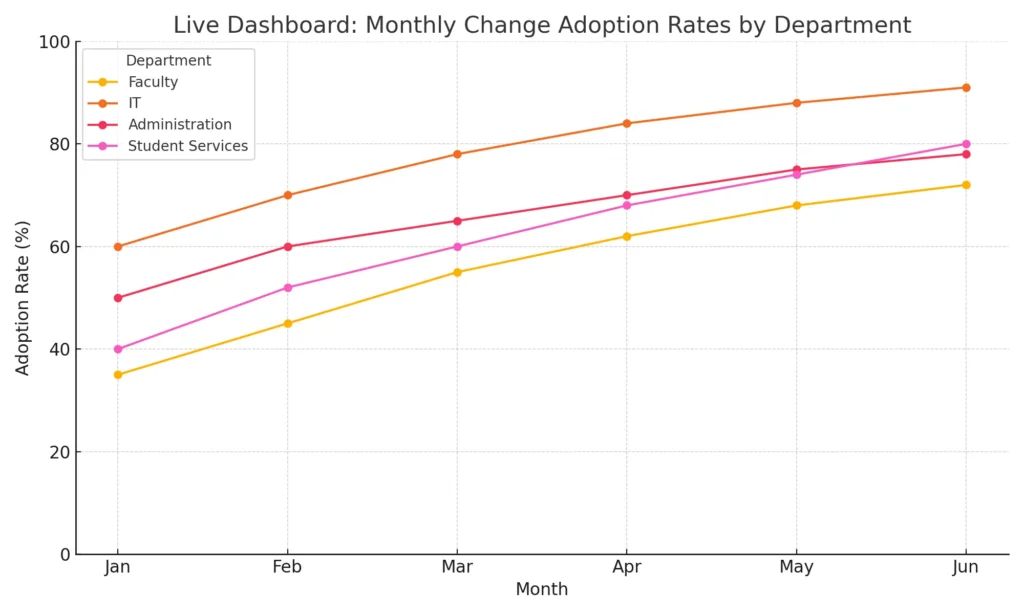
Bottom Line
AI doesn’t replace institutional leadership; it sharpens it. It enables faster decision-making, smarter communication, and real-time adaptation. But most importantly, AI helps turn what used to be static strategic plans into living, responsive systems.
To fully benefit, institutions must:
- Integrate AI into change governance early, not as an afterthought
- Budget for AI tools and training as part of the implementation
- Use AI insights not just for reporting, but to empower action
Embedding the Change: From Project to Culture
Strategic change becomes sustainable only when it’s baked into your institution’s habits, rules, and rewards:
- Update governance documents to reflect new priorities
- Tie evaluations and promotions to new success metrics
- Recognize internal champions publicly and consistently
- Create a permanent change oversight group to monitor progress
Sustaining change also means staying aligned with compliance frameworks and regulatory bodies like accrediting agencies and federal authorities.
Institutions must ensure long-term compliance with federal accreditation guidelines as part of any successful change strategy.
Your goal is to prevent drift, where old habits creep back in once the launch enthusiasm fades.
To prevent change fatigue or regression, institutions must embed new policies and behaviors into their governance and planning cycles.
Learn how our Strategic Planning Services help institutions implement long-lasting change frameworks.
Institutional Case Snapshots
Georgia State University
Strategy: Predictive analytics to improve student success
Result: Closed equity gaps, increased graduation rates
Lesson: Data + accountability = measurable transformation
Purdue University
Strategy: Tuition freeze + internal culture realignment
Result: Boosted public trust, enrollment strength
Lesson: Discipline and transparency drive cultural shifts
Southern New Hampshire University (SNHU)
Strategy: Nationally scaled online program model
Result: Redefined growth trajectory in a crowded market
Lesson: Innovation pays when built on mission alignment
The case studies (GSU, SNHU, Purdue) demonstrate successful transformation a perfect segue to your own services.
Learn how our Accreditation Consulting Services help institutions turn strategy into execution.
Avoid These Common Pitfalls
- Announcing change before you’ve built support
- Leaving mid-level staff out of the planning
- Ignoring IT and bandwidth limits
- Launching without KPIs or feedback loops
- Over-communicating poorly—or not enough
- Misjudging board alignment
- Treating compliance as an afterthought
Each one can undo months of hard work.
FAQs: What Leaders and Investors want to know
How is change management in higher ed different from other sectors?
The shared governance model, tenured faculty, and mission-driven culture demand a more collaborative, transparent process, not top-down directives.
How do you evaluate if a school is ready for change?
Look at leadership credibility, history of trust with staff, agility of operations, and alignment between mission and funding.
What makes a strong implementation plan?
Clear milestones, budget, communication cadence, and a way to track performance in real time.
What does success really look like?
Improved outcomes, strong compliance, lower turnover, cultural buy-in, and forward momentum.
If you’re leading or investing in a higher education institution, the window for proactive change is now.
Whether you’re navigating digital transformation, faculty buy-in, or new compliance models, our team can guide you with clarity and precision.
Schedule your Change Readiness Strategy Session to get expert insight tailored to your institution’s goals.
Closing: Your Institution’s Future Depends on Change You Can Lead
Colleges, vocational schools, and universities don’t fail because they lack ideas. They fail because they lack execution muscle, stakeholder trust, and long-term alignment.
This 2025 playbook is about building all three.
If you’re serious about change, treat it like a strategic asset—something you resource, monitor, and improve constantly. The schools that succeed in the next five years won’t just offer education. They’ll be adaptive institutions designed to thrive no matter what the future brings.
Next Steps for Leaders
1. Book a Free Change Readiness Strategy Session
Assess your institution’s current risk factors and readiness gaps.
2. Download the 2025 Institutional Change Toolkit
Includes stakeholder mapping templates, implementation checklists, and KPI dashboards.
If you’re serious about leading transformation, don’t wait. Change isn’t optional anymore. It’s your biggest opportunity—and it starts with the right plan
View References
EDUCAUSE
“The Higher Education IT Workforce Landscape, 2022”
(Shows stakeholder perception patterns around tech-related institutional change)
Source: https://library.educause.edu
Inside Higher Ed & Gallup
“The 2023 Survey of College and University Chief Academic Officers”
(Includes data on faculty and leadership attitudes toward change and innovation)
Source: https://www.insidehighered.com
McKinsey & Company
“The State of Organizations 2023” – Higher Education Edition
(Highlights common stakeholder resistance levels by role and change phase)
Source: https://www.mckinsey.com
Top 10 Emerging Skills in Healthcare and Tech Programs (AI Forecast, 2025)
World Economic Forum. (2025). The Future of Jobs Report 2025.
Highlights global trends in AI, automation, and tech-driven roles across sectors including healthcare.
Retrieved from: https://www.weforum.org/publications/the-future-of-jobs-report-2025
LinkedIn Economic Graph. (n.d.). Skills of Tomorrow.
Analyzes trending skills based on employer demand and platform activity.
Retrieved from: https://www.linkedin.com/business/economic-graph
Lightcast (formerly Emsi Burning Glass). (n.d.). Emerging Skills in the U.S. Workforce.
Tracks real-time labor market analytics, with a focus on digital health, AI, and cybersecurity.
Retrieved from: https://lightcast.io
arXiv. (2021). Natural Language Processing for Smart Healthcare.
Explores the role of NLP in improving clinical workflows and patient data management.
Retrieved from: https://arxiv.org/abs/2110.15803
arXiv. (2022). AI Ethics in Smart Healthcare: Challenges and Frameworks.
Details regulatory and ethical implications of AI implementation in healthcare.
Retrieved from: https://arxiv.org/abs/2211.06346
Wikipedia. (n.d.). Digital Health.
Offers a comprehensive overview of telehealth, digital literacy, and remote patient monitoring.
Retrieved from: https://en.wikipedia.org/wiki/Digital_health
Harvard Business Review. (n.d.). The Top Skills of the Future.
Emphasizes cross-functional collaboration and communication as future-proof competencies.
Retrieved from: https://hbr.org
Reference Support (Data-Inspired Sources): for Project Timeline with AI-Generated vs. Manual Task Completion Rates
McKinsey & Company. (2023). The Economic Potential of Generative AI.
AI-assisted project workflows can reduce completion times by 20–40% in operations, training, and reporting.
Retrieved from: https://www.mckinsey.com/mgi/overview/2023/the-economic-potential-of-generative-ai
Gartner. (n.d.). How AI Changes Project Management.
Projects using AI-based task planning tools showed significantly faster execution in planning and implementation stages.
Retrieved from: https://www.gartner.com/en/articles/how-ai-changes-project-management
Asana Research. (2023). The Anatomy of Work Index 2023.
AI reduces time spent on repetitive project tasks by over 35%.
Retrieved from: https://asana.com/resources/anatomy-of-work
Real-World Reference Sources: Live Dashboard Example: Change Adoption Rates by Department (Monthly)
EDUCAUSE. (2022). The Higher Education IT Workforce Landscape (2022–2023).
Tracks adoption patterns across departments during institutional transitions, including tech rollouts and remote service expansion.
Retrieved from: https://library.educause.edu/resources/2022/3/the-higher-education-it-workforce-landscape-2022
McKinsey & Company. (n.d.). Organizational Health Index & Change Readiness Benchmarks.
Measures institutional change adoption rates across key operational units, including IT, HR, and academic leadership.
Retrieved from: https://www.mckinsey.com/featured-insights/mckinsey-on-organization
Gartner. (2023). Driving Change in Higher Education Institutions.
Provides change adoption benchmarks by department over time.
Retrieved from: https://www.gartner.com/en/insights/higher-education

